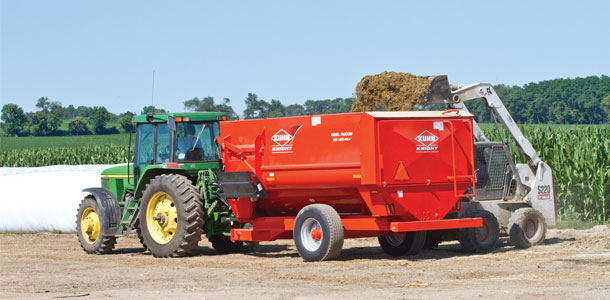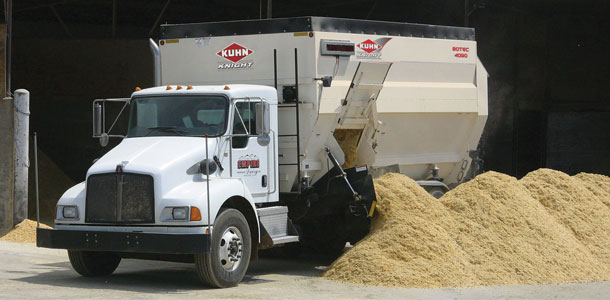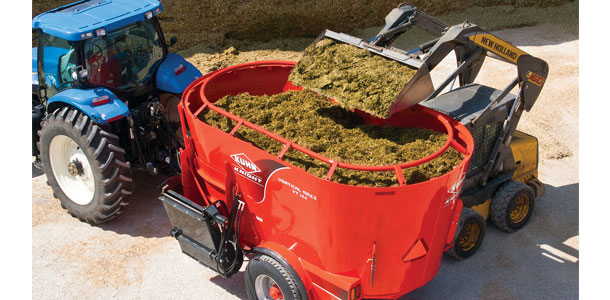I think it’s safe to say that when it comes to feeding cows, every dairy farmer has the same end goal in mind: a consistent ration the full length of the bunk. Considering the choices in ration ingredients, feed storage methods and processing methods, this common end goal can be achieved in a variety of ways. How can you select the mixer that is best suited for your farm? This article will discuss the capabilities and characteristics of the three most common TMR mixer types.

The rotary or reel mixer
A horizontal reel sweeps tumbling feed toward two augers running the length of the machine. In most cases, these augers move feed in opposite directions. This crisscrossing action helps blend the ration while leveling the load and providing delivery to the feedout door for emptying the mixer.
The most basic of reel mixer designs use straight crossbars with a center tube joined together by two end supports. This basic straight bar reel design works well for flowable rations but is limited in its ability to mix dense, sticky commodities and rations containing more than 10 percent long-stem hay.
As an alternative to the straight bar reel, the Helix reel has spiral crossbars with an open center that allows for greater fluid movement of feed ingredients and improved performance with dense, sticky commodities and rations containing up to 20 percent long-stem hay. All reel mixers, both straight bar and Helix, are more suited for mixing small batches, for example, pre-fresh rations.
As a result of the reel’s tumbling action, all ingredients (no matter how small the batch) are thoroughly blended. Reel mixers provide a gentle mixing action and result in the fluffiest rations. It is because of the fluffing and tumbling action that reel mixers are the most susceptible to overloading concerns. Reel mixers must not be overfilled or mix quality will be compromised.

The horizontal auger mixer
Horizontal auger mixers come in three- or four-auger configurations. Four-auger mixers are more common. Generally speaking, the lower augers move feed forward while the upper augers move it rearward. The feed convergence area at the front of the mixer pushes feed upward into the upper augers and then moves it to the rear of the mixer. This creates a “front to back” and “up and down” cyclical action within the mixer.
Horizontal auger mixers produce more pressure as they compress ration ingredients rather than fluff as compared to the reel mixers. The pressure exerted on feed ingredients provides the opportunity to process limited amounts of long-stem hay up to 20 percent.

The vertical auger mixer
Vertical auger mixers are available in single-, twin-, or triple-auger configurations. In these mixers, the augers pick up and elevate the material vertically, thus creating the “up and down” feed mixing cycle. The rotation of the augers gives the “front to back” feed mixing cycle while sidewall baffles direct feed transfer from chamber to chamber.
The open top mixing chambers and upward movement of feed allow for 100 percent long-stem hay processing capabilities. Vertical mixers blend ration ingredients using a “boiling” action; for this reason, they do not work well for small batches or premixes due to lack of volume. PD
Troy Moen is product specialist for Kuhn North America.
PHOTOS
Photos courtesy of Kuhn North America.




